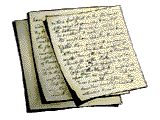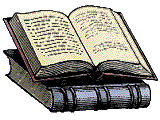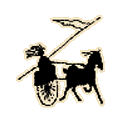
|
THE SPALDING
RESEARCH PROJECT |

|
Dale R. Broadhurst's "Spalding Papers"
"Index" -- 01 02 03 04 08 09 10 11 12 13 14 15 16 -- "Home"
Paper 12 - Part IIIa
Commentary on M. D. Bown's
Book of Mormon / Spalding MS Parallels
Numbers 01-14

Revision 0a: September, 1998
Editorial and Bibliographic Information
Go Back to Intoduction & Index [ pp. 01 to 06 ]
|
ITEMIZED LIST OF PRESUMED SIMILARITIES Between Spaulding's "Manuscript Story" and the Book of Mormon Specific and single similarities have been isolated, listed separately, and numbered, with the paralleling citations from each work following. Whenever possible, direct quotations have been made. Only when necessary has discussion been utilized, and here care has been taken that the duplicating references are amply and accurately recorded -- but even so, errors no doubt will appear. This method of listing parallels is cumbersome perhaps, and has involved exceeding labor in preparation; but it seems to have the merit of providing direct comparison between the two works with a minimum of vagueness. "MS" refers to Solomon Spaulding's "Manuscript Story," the edition used being published at the Millennial Star Office, Liverpool, England, 1910, 116 pages. "BM" refers to the BOOK OF MORMON, and the edition used was published by the Church of Jesus Christ of Latter-day Saints, Salt Lake City, 1920, 522pp. Please Read These Notes First: 1. All additions to Bown's original paper are shown in blue. 2. Commentary here as a summary; For full commentary follow the links. 3. The Commentator's Personal Ratings of Bown's Parallels: * poor parallel or not a parallel: should have been dropped Some On-line Textual Resources: 1. Search the Book of Mormon: LDS and RLDS texts (side-by-side scrolling comparison) 2. Search the Book of Mormon: Current LDS edition (includes phrase search) 3. Search the Book of Mormon: 1830 edition (includes concordance functions) 4. Search the Spalding MS: Special e-text version (includes concordance functions) 5. Search the Spalding MS: Special e-text (side-by-side with 1830 Book of Alma) 6. Search the Spalding MS: LDS 1910 edition (the edition used in Bown's citations) 7. Read Holley's book: Book of Mormon: A Closer Look (Spalding / BoM Comparisons) 8. Search the Bible: King James version (includes Apocrypha & concordance functions) 9. Search Ethan Smith's Book: View of the Hebrews (includes concordance functions) |
|
01. Both are accounts of early inhabitants of America MS -- The party of Romans arriving in the New World found many tribes of Indians already present and well-established, and offers no suggestion concerning the actual origin of the Indians. However, Fabius records that the Ohons resemble their savage neighbors so little that "they must have originated from some other nation," (p. 21) BM -- The small party of Israelites who left Jerusalem to come to the "Promised Land," which is always interpreted as the present American content where the first inhabitants who left descendants and are therefore the ancestors to the modern Indians. The Jaredites, who had preceded the Israelite party, were entirely destroyed in civil war, save two men: Coriantumr and Ether (the Jaredite historian). After the destruction of his people, Coriantumr "was discovered by the people of Zarahemla, and he dwelt with them for the space of nine moons." (Omni 21). There is no further record of either survivor -- presumably they left no descendants. Comment summary on item #01: ** Bown generalizes the accounts. All three "records" (the Roman, Jaredite, and Lehite) contain accounts of Old World peoples who eventually become New World inhabitants. Bown errs in saying Spalding "offers no suggestion concerning the actual origin of the Indians." (more comments on item #01) 02. In both accounts the civilization of these inhabitants was much higher than that of the modern Indian. MS -- The presence of savage tribes is recounted, but the major portion of the work describes two races of people that had achieved a high development in religion, industry, commerce, and material wealth; even a flying machine is mentioned as the invention of Lobaska (p. 33). BM -- In general, the Nephites seem to be the bearers of progress, developing significantly in agriculture, metallurgy, building, shipping, etc. far beyond the modern Indian ethnic groups. (Cf. Sjodahl, op. cit) Comment summary on item #02: ** Many native peoples were as "civilized" as their European conquerors. This point aside, Bown is correct in showing that both Spalding and the Book of Mormon writers portray some of the ancient inhabitants of the Americas as possessing a more developed technology and a higher degree of social organization than the later native peoples. (more comments on item #02) 03. Both works pretend to be records of events that actually occurred, and not mere fiction. MS -- Since Spaulding prefaces his alleged translation with an expression of keen interest in the evidences of early American civilization, and for other reasons, his pretension would scarcely [have] deceived anyone. BM -- No similar observation may be made in this case, for so far as can be determined, Joseph Smith never evidenced any special interest in early American inhabitants; and the claim that this work is historical and not fictional is presented with almost disconcerting assurance. Comment summary on item #03: ** Both works do present themselves as true histories, but it's unknown whether Spalding wrote his romance an obvious historical fiction. Even if he wrote his story to be a believable history, it still remains unbelievable. He probably intended it as a parody, but he may have expected to foist this "sacred roll" on some less learned folks. (more comments on item #03) 04. Include religious and moral as well as historical accounts. MS -- A five page chapter (pp. 27-32) is devoted to a discussion of the religion of the Ohons with many admonitions concerning one's moral and ethical obligations. In addition, Lobaska is quoted dictating many moral precepts. The section on religion ends" "Be attentive O man to the words of truth which have been recorded & pay respect to all the commandments which have been written for your observance" (p. 32). BM -- References to religious and moral principles are so numerous and scattered throughout this work that it seems unnecessary to cite instances. The Ten Commandments are given in Mosiah 13:12-25 and summarized in 2 Nephi 26-32. Comment summary on item #04: ** Spalding's preoccupation with religion is never far out of sight; even when he does not not mention it directly. He soon drops his Christian religious elements but the whole of Spalding's story remains a disguised critique of the social, political, and religious practices of his day. Spalding was either an atheist or an agnostic deist. However, the Book of Mormon is strongly Judeo-Christian. This is one of the most significant un-parallels between the two works. (more comments on item #04) 05. Both works use "Bible language." MS -- Only a small part of this work uses this device, being confined to the moralizing: The following may be considered typical: "Defraud not thy neighbor, nor suffer thy hands secretly to convey his property from him." "Preserve thy body from the contamination of lust." "Be grateful for all the favours & forsake not thy friend in adversity." "Bow down thy head before the aged . . . & place thy rulers and thy teachers in the most honorable seats." "Let the stranger find a hospitable place under thy roof." BM -- This work is throughout very similar in rhetoric, construction, use of words, etc., to the King James version of the Bible.1 Comment summary on item #05: ** Spalding sometimes used fragments of archaic English. He also makes use of the same textual devices found in the Book of Mormon, where biblical textual fragments are inter-woven with non-biblical language, but his old-fashioned words are not always exclusively "Bible language." (more comments on item #05) 06. Some proper names are similar. MS -- Como Hemock Labanco Hammath Moonrod Ramoff BM -- Com Hem Laban Hamack Nimrod Ramath Comment summary on item #06: ** A few Spalding names sound vaguely like Book of Mormon names, but the only real matches are "Jesus Christ," "Egypt," and "Chaldea" / "Chaldeans." Some original names in the two texts are constructed in the same way: by resuing syllables occurring in other names. Also, both works appear to draw some names from the same classical works. Many of Bown's quotes of names from Spalding are mis-spelled, however. (more comments on item #06) 07. Both use a similar literary device to support a claim of historical authenticity.2 MS -- Spaulding pretended to have obtained the basis of his work from a manuscript of "twenty-eight sheets of parchment" which he said he found. (p. 2) BM -- Copies of this work are prefaced by Joseph Smith's account of finding the plates on which the work is based. Descriptions of these vary, but Smith himself once described them: "These records were engraven on plates which had the appearance of gold; each plate was six inches wide and eight inches long and not quite so thick as common tin. They were filled with engravings, in Egyptian characters, and bound together in a volume as the leaves of a book with three rings running through the whole. The volume was something near six inches in thickness . . ."3 Comment summary on item #07: * Similarities in these discoveries are not parallels of the texts themselves. Also, the RLDS 1885 printed edition has "twenty-eight rolls of parchment," not "twenty-eight sheets." Bown missed the parallel that a portion of both records was to be held back from public view until some later day. (more comments on item #07) 08. In each case the original records were written by individuals who actually lived during the time of the events related. MS -- The original manuscript was written by a Roman soldier named Fabius who lived among the people described. He could not have lived during the full period chronicled, however, apparently obtaining much of his history from the peoples themselves, although the record does not so declare. His description of the Ohon religion was obtained from their "Sacred Roll." (p. 28) BM -- In general, the fifteen books of this work were written by individuals for whom they are named, and use the first person, singular throughout. Much of the engraving and abridging was done by others, however. (Cf. preface entitled "Brief Analysis of the Book of Mormon"). Comment summary on item #08: *** Spalding had his Fabius summarize the ancient history from written and oral sources. The Book of Mormon contains a variety of writings, not all of which were autographs. Both accounts do claim to have been written by ancient people whose stories they contain. (more comments on item #08) 09. Both related events occuring during several hundred years. MS -- Fabius left Rome after the time "that Constantine arrived at that city & had overcome his enemies & was firmly seated on the throne of the Roman empire." (p. 4) Constantine became Emperor 324 A.D. But whether the Roman party arrived before during, or after the Sciotan-Kentuck war is not even hinted. The War, however, is preceded by "an uninterrupted peace and friendly intercourse for the space of four hundred & eighty years." (p. 55) And events even prior to the peace, covering a number of years, are related. BM -- The period covered by the major portion of this work is customarily said to be from 600 B.C. to 421 A.D., or over one thousand years. The Jaredites, whose story is related in the Book of Ether, arrived much earlier, having left their Old World home at the time of the Bible episode of the Tower of Babel, whenever that was and survived in the New World until about 600 B.C. Comment summary on item #09: ** Spalding's timeline roughly matches that of the Nephite record, but not the Jaredite record. His fictional Lobaska may have an approximate contemporary of Lehi, and his Fabius deposited his Latin "roll" in the ground no later than 400 CE. Spalding's great war of extinction probably ended between 330 and 400 CE. (more comments on item #09) 10. The extant records represent abridgements of the originals. MS -- Spaulding pretended to abridge the record of Fabius: "To publish a translation of every particular circumstance mentioned by our author would produce a volume too expensive for the general class of readers. But should this attempt to throw off the vail which has secluded our view from the transactions of nations who, for ages have been extinct, meet the approbation of the public, I shall then be happy to gratify the more inquisitive & learned part of my readers by a more minute publication." (p. 3) Fabius apparently abridged part of the records: "That you may know the Author I will give a succint account of his life & of the cause of his arrival -- which I have deposited with this history." (p. 4) Again: "From the sacred Roll as it is denominated I shall extract the tenets of their Theology . . . (p. 28) BM -- Nephi wrote: "Behold, I make an abridgment of the record of my father, upon plates which I have made with mine own hands; wherefore, after I have abridged the record of my father then will I make an account of mine own life." (1 Nephi 1:17) Mormon wrote: ". . . for after I had made an abridgment from the plates of Nephi, down to the reign of this king Benjamin . . ." (Words of Mormon 3) Cf. also Mormon 5:9; Moroni 1:1 Comment summary on item #10: ** Both accounts do represent themselves as being condensations of larger works. Spalding does not use the Book of Mormon term "abridgement," however. (more comments on item #10) 11. The records were deposited for safekeeping by the historian himself. MS -- "As it is possible that in some future age this part of the earth will be inhabited by Europians & a history of its present inhabitants will be a valuable acquisition, I propose to write one & deposit it in a box secured --- so that the ravages of time will have [no] effect upon it." (p. 3) BM -- When the Nephites fled before the victorious Lamanites Mormon removed "all the records which Ammaron had hid up unto the Lord." (Mormon 4:23) Subsequently, the final struggle between the two nations took place near a hill called Cumorah. The Nephites were faced with certain defeat, so their leader, Mormon, "having been commanded of the Lord that I should not suffer the records . . . to fall into the hands of the Lamanites . . . therefore I made this record out of the plates of Nephi and hid up in the hill Cumorah all the records which had been entrusted to me by the hand of the Lord, save it were these few plates which I gave to my son Moroni." (Mormon 6:6) Presumably Moroni wrote the remainder of the work, finishing the record of his father (Cf. Mormon 8:1) and then undertaking to "hide up the records in the earth" (Mormon 8:4), no doubt also in the hill Cumorah. Cf. also Ether 15:11, 2 Nephi 27:22, 4 Nephi 1:48, etc. Comment summary on item #11: *** Spalding's Fabius and the Book of Mormon's Moroni are compilers and editors, if not historians. Both bury their abridgements and other ancient writings for a future discovery. Presumably Fabius, like Moroni, survived the great ancient war of extinction mentioned in both works. (more comments on item #11) 12. They were subsequently found in a box buried in the ground. MS -- This record was found in "an earthen Box . . . two feet in length, one & half in breadth & one and three inches in diameter," which was in a cave lined with stone. (pp. 1-2) BM -- Joseph Smith wrote: "On the west side of this hill, not far from the top, under a stone of considerable size, lay the plates, deposited in a stone box."4 (See my comments on item #07) 13. The cover had to be pried up, MS -- "With the assistance of a leaver I raised the Stone." (p. 1) BM -- "Having removed the earth, I obtained a lever, which I got fixed under the edge of the stone, and with a little exertion raised it up."5 (See my comments on item #07) 14. The records required translation. MS -- The twenty-eight sheets of parchment Spaulding said he found were "written in an eligant hand with Roman Letters & in the Latin Language." which he himself translated. BM -- The plates Joseph Smith found "were filled with engravings, in Egyptian characters . . . With the records was found a curious instrument, which the ancients called 'Urim and Thummim,' which consisted of two transparent stones set in the rim of a bow fastened to a breast plate. Through the medium of the Urim and Thummim I translated the record by the gift and power of God."6 Comment summary on item #14: ** Bown didn't mention that secular scholarship would see Latin and "reformed" Egyptian as being unknown to the pre-Columbian Americans. Also, it seems incredible that a Vermont clergyman could read and translate idiomatic 4th century Latin; but then Smith's translating might sound equally incredible to non-Mormon readers. (more comments on item #14) Go to: item #15 |
Commentary on M.D. Bown: [Index] < - > [parallels 15-24] [parallels 25-47] [parallels 48-59]
[parallels 60-78] [parallels 79-99] [Bown's Notes] [Names Index] [Editorial & Bibliographic Info.]
Spalding Studies Home Page: [Introduction] [SRP] [Broadhurst Papers] [E-mail Site Host]
revision 0a: September, 1998